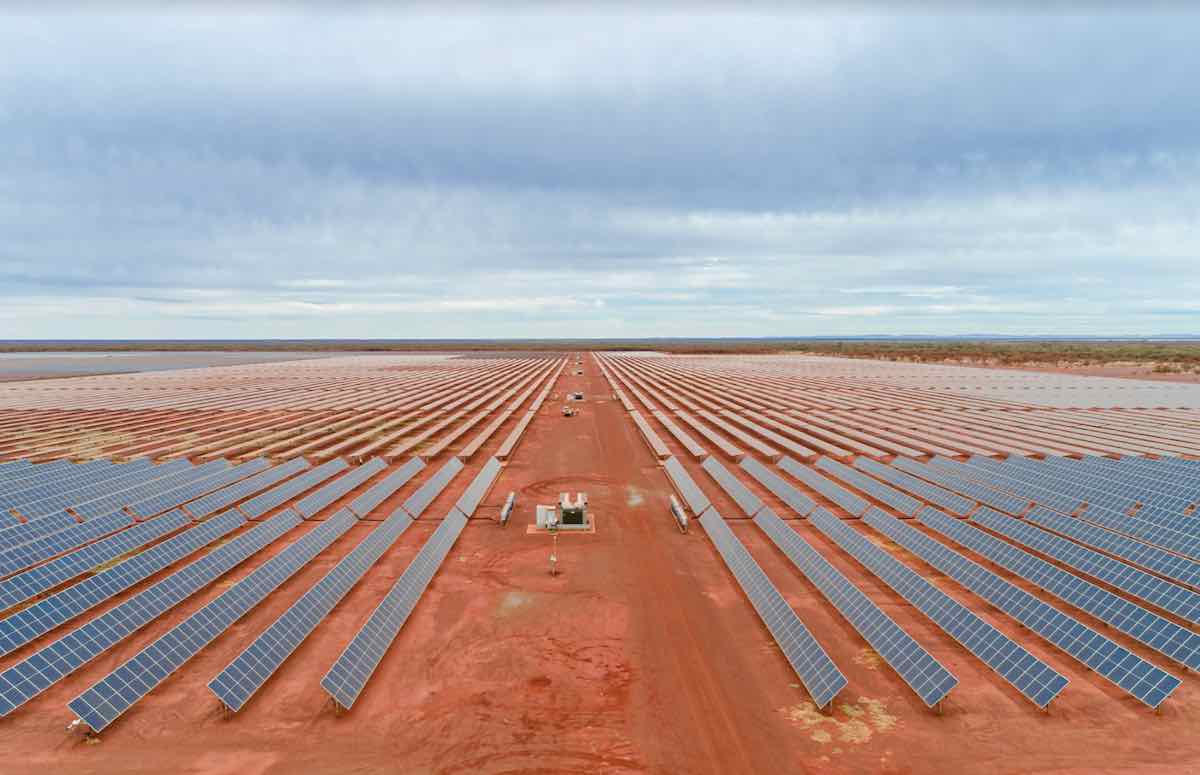Andrew Forrest’s iron ore and green energy group, Fortescue Metals, has started production from its first solar farm as it begins to gather wind assets and advance electric and hydrogen transport technologies in its quest for “true zero”. “, green hydrogen and “green iron” in development. ” market in China.
The company announced on Thursday that production has started at the 100 megawatt (MW) North Star Junction solar farm near its new Iron Bridge mine in the Pilbara.
It is the first solar asset to be built by Fortescue, although the 60MW Chichester solar project (pictured above), built by Alinta Energy and now owned by APA Group, has helped power the Cloudbreak and Christmas Creek iron ore mines in Pilbara.
The North Star solar farm isn’t complete yet, but it’s the first big step, along with several recently completed battery storage projects, in the company’s ambitious goal of reaching “real zero” by 2030 for its iron ore operations – meaning it won’t burn any fossil fuels for electricity or transport.
To achieve this, Fortescue will need to build several gigawatts of new wind and solar capacity, along with storage backup, to replace the gas and oil generators that currently power its operations, as well as used oil for its giant trucks and other transport. and mining needs.
Progress is being made, with trials for fully electric and hydrogen hybrid trucks, electric excavators and work on a so-called battery-powered “infinity train,” although not much has been heard about it in recent months.
Fortescue is currently enjoying record shipments of iron ore so it is not short of a dollar, although it admits costs are rising and recently announced 700 job cuts as part of its plans to streamline operations.
It has admitted that its ambitious green hydrogen plans to produce 15 million tonnes a year will not be realized by 2030 as it had hoped.
Despite this, Fortescue Energy boss Mark Hutchinson says the green hydrogen goals are still valid, but with a different timeframe, and insists the “real zero” target – which compares to the agreed 2050 “net zero” by most corporations – still is. in place.
“So at ground zero for our company, we’re absolutely committed to it and we’re progressing extremely well,” Hutchinson told analysts and media on Thursday in response to a question from Renew Economy.
And he’s not giving up on the green hydrogen market.
“As the green hydrogen market develops around the world, it’s really clear that the cost of green energy, which is obviously how you get started with green hydrogen, needs to be in the $30 range to make the projects applicable,” Hutchinson said.
“Therefore, where electricity costs are not at this level, we will work hard with those economies to help reduce the cost of electricity by producing electrons. For example, we will explore opportunities to produce electrons from our portfolio with Australia and Queensland.
“Long term, we strongly believe that green hydrogen is what the world ultimately needs. That is why we will continue to maintain an important portfolio project. We are realistic about the pace of the current global energy transition, which is why our initial focus is on four green hydrogen projects across Australia, the United States, Norway and Brazil.
Asked if the $30/MWh price was possible in Australia, Hutchinson said it was difficult – but most likely at its base in Western Australia and Queensland where it is pursuing several projects and has announced the first electrolyser customers of Gladstone hydrogen. plant.
Fortescue, as reported in the AFR on Thursday, has quietly transferred ownership of two gigawatt-scale wind projects – Prairie and Wongalee in Queensland – from Windlab, which is majority-owned by Forrest’s private interest, to Fortescue.
Hutchinson said these projects could be used to provide electrons for energy, or in her green hydrogen ambition. Much would depend on the progress of the Copperstring 2.0 transmission project, which will help unlock renewables and large mineral projects. “At the moment it’s too early.”
Meanwhile, Fortescue CEO Dino Ostranto was particularly positive about China’s emerging green iron market, which Fortescue hopes to tap.
“I’ve been in China all week, meeting with potential partners and steel mills on the possibilities of Australia and China joining forces on green iron,” he said.
“Metal is the next step for us and we see great potential in building a green iron industry out of Australia, supplying China with some of the announcements we’ve heard this week.
“Starting next year, all coal-fired power plants in China will begin their low-carbon transformation as part of the government’s commitment to halve emissions from coal-fired power plants by 2027, and by the end of the decade, this shall mean all coal-fired power units. will be able to burn coal more than 10% green ammonia.
“Not only do I remain confident about the outlook for steel and iron ore demand, but I am excited about how we will continue to work with China as we decarbonize our exploration value chain.”
